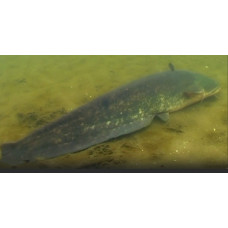Latin name
Silurus glanis
Other name
Sheatfish or wels.
Identification
The Wels catfish can be distinguished from other catfish by its two pairs of antennae, naked body, and large, depressed head.
Features of fish fins
Dorsal spines (total): 1
Dorsal soft rays (total): 4-5
Anal spines: 1
Anal soft rays: 83-95.
The anal fin is long and the adipose fin is absent. The unpaired fins lack spines.
Fish colouring
The coloration is usually brown with shades of brown-green, and the belly is white. Depending on the habitat, the color can range from nearly black to light yellow. Sometimes albino catfish are found.
Distribution
Wels catfish inhabit rivers and lakes in Europe and Asia. They are found in the Northern, Baltic, Black, Caspian, and Aral Sea basins, extending northward to southern Sweden and Finland. They are also found in the Aegean Sea basin in the Maritsa River and from the Struma River to the Sperchios River in Turkey. They are absent from the rest of the Mediterranean basin. They are now widely introduced and dispersed throughout Europe and the Balkhash Lake basin in Kazakhstan. Several countries report adverse environmental impacts following their introduction.
Habitat
This is a benthopelagic species that prefers freshwater and brackish water. It lives at depths ranging from 0 to 30 meters.
Temperature: 4°C to 20°C. It occurs mainly in large lakes and rivers, although it occasionally enters brackish water.
Size
Its body length can reach up to five meters and its mass can reach up to 400 kilograms.
A catfish weighing 306 kilograms, measuring over three meters in length, and estimated to be about 80 years old has been officially confirmed to have been caught. Catfish weighing over 100 kilograms are now extremely rare. However, there have been cases of catching catfish over 8 feet long and weighing about 330 pounds. The maximum reported age is 80 years.
Behavior
It occurs in the deep waters near dams built in the lower reaches of rivers. They do not migrate. Before the reservoir freezes over, catfish gather in small groups of five to ten individuals around holes. They do not feed in the winter and are practically inactive.
Food and feeding habits
It is an active nocturnal predator. During the day, it prefers to rest in holes, snags, and other secluded areas.
There is a misconception that catfish feed only on carrion. In fact, this is not quite true. At an early stage of development, the main food of catfish are small crustaceans, fry, and aquatic insects. As it matures, depending on the food available, it prefers live fish, other freshwater animals, and mollusks. Catfish have also been known to attack waterfowl and small domestic animals.
Reproduction
They spawn in the spring among the aquatic vegetation in the coastal zone. They usually reach sexual maturity in their fifth year of life. Males defend small territories in the spawning area and build nests from plant material. They dig shallow depressions or clear the substrate, such as willow (Salix) roots, for spawning. Males guard the nests until the larvae emerge. They spawn in pairs. The eggs hatch in two to three days. The larvae live in the nest for two to four hours until the yolk sac dissolves. The eggs are covered with a mucous membrane. Incubation lasts about 50 hours at 24°C. The egg size is 3 mm, and the larval length at hatching is 8.5 mm.
Fishing
Fishing for wels catfish is common in many regions. Catfish have long been a source of food.
Relationship with a person
Although attacks by large catfish on humans, especially children, have been described, they have not been documented.
Interesting Facts
When these night hunters are looking for a meal, they use all their tools: their lateral line, sight, hearing, smell, and touch. But if they can't use all their senses for some reason, they can get by with just one or two.
| Classification | |
| Phylum | Chordata |
| Class | Actinopterygii |
| Squad | Siluriformes |
| Family | Siluridae |
| Genus | Silurus |
| Species | S. glanis |
| Features | |
| Conservation status | Least Concern |
| Habitat | Pelagic |
| Life span, years | 80 |
| Maximum body weight, kg | 400 |
| Maximum length, cm | 500 |
| Sailing speed, m/s | No information |
| Threat to people | Edible |
| Way of eating | Predator |
Wels catfish
Tags: wels catfish


